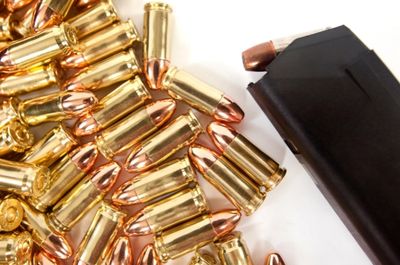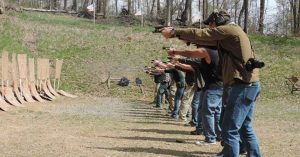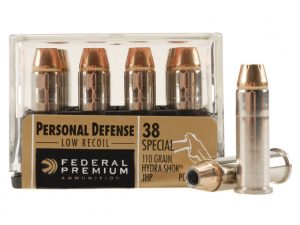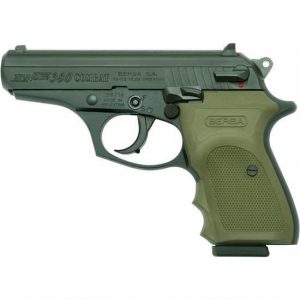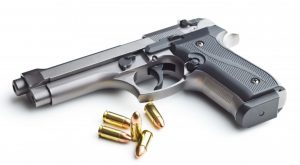The AR-15 is as American as it’s possible for a rifle to be. Originally designed for the U.S. Armed Forces by the late, great Eugene Stoner in the 1950s, the AR-15 would go wherever our troops went – first as the M16, and then as the M4 carbine. Thanks in no small part to veterans’ preference for a firearm they’re already accustomed to firing, the AR-15 has become the most popular rifle in the American civilian firearm market – the world’s largest civilian firearm market, needless to say.
But it’s not just the AR-15’s history that makes it American. The rifle’s intuitive, ergonomic design and ease of operation make it truly accessible to anyone, whatever their experience with firearms might be. The AR-15’s customizability also makes it an everyman’s rifle. You have total control over your own AR-15’s parts and accessories and can swap them out in a matter of minutes whenever the mood or need strikes you.
Don’t let Big Tech or the Woke Left convince you that the AR-15 is some dangerous “weapon of war that has no place on our streets.” It owes its popularity to good, law-abiding citizens who want a rifle they can easily build, maintain, and master, and is a true symbol of the average American’s right to defend themself and their own. It’s also a real hoot when you’re just looking to have some fun at the range.
Another reason for the AR-15’s popularity is the great variety of ammunition it can fire. Without question, 5.56×45/223 Rem are the most popular cartridges for AR-15 builds, but a few new parts will adapt an AR-15 for several other cartridges including 300 AAC Blackout, 7.62×39, 450 Bushmaster, 9mm, 40 S&W, and even 22 LR.
Lots of folks who just bought their first AR-15s often ask: What kind of ammo should I buy for my rifle? Well, that largely depends on what kind of shooting you plan on doing. Target shooting? Home defense? Hunting? There are ideal cartridges for all of these applications.
Before we start talking about ammo, let’s briefly touch on the differences between 5.56×45 and .223 Rem. The vast majority of AR-15s can fire both, but that comes with a caveat.
5.56×45 vs. 223 Rem: What’s the Difference?
Let’s not get too bogged down in cartridge specifications and technicalities here. In short, 5.56 and .223 cartridges share virtually identical physical dimensions. If you placed the two next to one another, you’d be hard-pressed to tell which is which without looking at their headstamps.
The major difference between the two rounds is one you can’t see: The 5.56 is loaded to generate a slightly higher chamber pressure. This basically means the 5.56 round produces a more powerful explosion than the .223 during ignition.
What does this mean? Only that a firearm chambered for 5.56 can also safely fire .223, as it is more than capable of absorbing the slightly weaker round’s chamber pressure. But the opposite is not true. A firearm chambered for .223 can become badly damaged by firing 5.56 ammo.
This isn’t a big problem for AR-15 owners, as their rifles nearly certainly have more versatile 5.56 chambers. On a final note, look into the .223 Wylde chamber if you are able. It is similarly designed to fire both 5.56 and .223 ammo safely, but its internal geometry is better optimized to give both cartridges their best accuracy.
Best AR-15 Ammo for Target Shooting
Targets aren’t going to fight back. While you would ideally avoid failures to feed and extract while you’re doing your thing at the rifle range, a dud isn’t going to compromise your safety. A squib load can hurt you, however, as it will deposit a bullet in your barrel to cause the next shot to blow up your rifle, but the point we’re getting at is this: You’re allowed to buy cheap ammo for the rifle range.
Full Metal Jacket (FMJ)
The FMJ is the simplest bullet design for a semi-automatic firearm. This bullet has a solid lead core and gilding metal jacket, and will feed smoothly, prevent excessive barrel fouling, and maintain a flat, accurate trajectory throughout its effective range.
Not all FMJ bullets are created equal. Many cartridges (mostly steel-cased ones from Russia) are loaded with bullets that have bimetal jackets. Bimetal jacketed bullets are functionally identical to regular FMJs. Their jackets are made of cost-effective steel with a thin copper wash coating on the exterior. The main shortcoming with bimetal jacketed bullets is that they have a higher chance of creating sparks or a ricochet, as well as damaging range equipment. This is why several commercial ranges ban “magnetic” ammunition.
You may encounter M193 ammunition during your search for FMJ ammo. This is a military designation and simply means the cartridge has a 55-grain FMJ loaded to a muzzle velocity around 3,240 feet per second (fps). Like all FMJs, the M193 round’s bullet is not designed to expand as it penetrates soft tissue. That said, it will likely fragment into three or more pieces of shrapnel following impact at 2,500 fps or faster, which does make its terminal ballistics more effective for personal protection.
You may also encounter M855 ammunition. This is also an FMJ cartridge, but its 62-grain bullet is not magnetic because it has a bimetal jacket. The M855 bullet’s jacket conceals a seven-grain steel “penetrator” tip, which enables it to pass through sheet metal and other obstinate barriers. The M855 round’s combat applications are self-evident, but you may also use it for target shooting. Just take care that it will damage a steel target!
Frangible
Frangible bullets are essentially made of compressed non-lead metal powders including tin and copper. When a frangible bullet strikes a surface harder than itself, it will instantly disintegrate. This makes target shooting safer as the frangible bullet virtually eliminates the chance of a dangerous ricochet or splash-back. Lead-free frangible bullets also keep an indoor range’s air much healthier to breathe.
Some people use frangible bullets for home defense. They do so because frangible bullets are less likely to pass through several walls to jeopardize an innocent bystander. Adopt this home defense strategy with a grain of salt, though – a frangible bullet can still punch through a human-sized target and several layers of wallboard.
Boat Tail Hollow Point (BTHP)/Open Tip
BTHP and open tip bullets may superficially resemble the kinds of hollow point projectiles you would use for self-defense with a handgun, but they are in fact not designed to deliver terminal expansion within soft tissue (with a few exceptions, such as the Berger Hybrid Hunter). These bullets’ nose cavities exist because their lead cores were poured into place while they were still molten. As the result of their form-fitted cores, these bullets boast superior rotational stability.
BTHP and open tip bullets are favored for long-range target shooting. Their balanced cores promote greater accuracy, as do their ballistically efficient boat tails (which help the bullet retain more velocity throughout its trajectory so it can fly flatter and resist wind deflection). These bullets are generally manufactured according to a higher standard than regular FMJ bullets.
Best AR-15 Ammo for Home Defense
To be very certain, any target shooting cartridge is capable of quickly neutralizing a human-sized threat. An FMJ bullet may not expand, but at the end of the day, a sharp piece of copper-coated lead traveling at nearly three times the speed of sound cannot do any favors to its target.
That said, there are better solutions for self-defense than FMJ, BTHP, or frangible bullets. You would ideally have terminal expansion – in which the bullet widens inside of its target – for three reasons:
- An expanding bullet gouges a wider wound channel into its target to inflict greater damage.
- An expanding bullet exerts more of its energy in lateral directions instead of only forward, which similarly inflicts greater damage.
- An expanding bullet is less likely to pass through its target, thus reducing the chance of collateral damage (i.e. hitting an innocent bystander).
Soft Point (SP)
SPs are the most popular self-defense projectiles for AR-15 rifles. The SP’s jacket stops just short of covering its lead core at the tip. This enables the pliant lead core to flatten down throughout penetration, taking on a mushroom shape in the process.
Higher quality SP bullets will have bonded jackets. Bonding helps to prevent the SP’s jacket and core from separating from one another. As the result, the SP retains more of its mass as it tunnels into its target, which in turn preserves the momentum the bullet needs to penetrate deeply.
SP bullets may be marketed for deer hunting instead of self-defense. These projectiles are absolutely suitable for defending your homestead, however, as the terminal performance which fells a deer is by all means powerful enough to neutralize a tenacious threat.
Note that an SP bullet may also be called a jacketed soft point (JSP). For all intents and purposes, it is the same type of projectile.
Polymer Tip
Although some polymer tip bullets are strictly designed for long-range target shooting, polymer tip 5.56/223 rounds are virtually exclusively intended for hunting or self-defense. When a polymer tip bullet that is designed for self-defense plunges into soft tissue, its tip smashes into its lead core’s concealed nose cavity to force the bullet to spread outward in a rapid display of terminal expansion.
A caveat about polymer tip bullets: Even if they are designed for hunting, they may not necessarily be ideal for personal protection. A polymer tip varmint hunting bullet is designed to expand and/or explode in a flurry of shrapnel the instant following impact. This makes its terminal ballistics extremely deadly to rodents and other small game, but also makes it unable to reliably penetrate to the depth where a human-sized threat’s vital organs are stored.
Best AR-15 Ammo for Hunting
The important question here is what kind of hunting you want to do: varmint (and possibly predator), or whitetail. Small game is best hunted with bullets that expand very quickly, whereas medium-sized game demands significantly deeper penetration to ensure a fast, humane kill.
Varmint: Polymer Tip or JHP
You can go varmint hunting with any kind of bullet. A ground squirrel, which weighs about a pound, is absolutely going to die when an FMJ hits it. But you can do better by selecting hunting ammo that is specifically marketed for varmints.
Whether it’s a polymer tip bullet that’s designed for virtually instantaneous expansion following impact (such as the Hornady V-MAX or Barnes Varmint Grenade) or a JHP (such as the Speer TNT Green) that is similarly optimized for fast terminal expansion, it’s an excellent choice for varmint hunting. You may also look for ammo that’s optimized to deliver superior accuracy because hitting so small a target at long range can be quite difficult.
Deer: Soft Point (SP) or Polymer Tip
For deer hunting, you would be well advised to pick an expanding bullet. A 5.56 or 223 cartridge is relatively weak as far as deer hunting is concerned, so terminal expansion will help to drop so rugged an animal that much faster. Furthermore, many jurisdictions require expanding bullets during deer season for ethical reasons.
SP bullets are excellent for deer hunting. Winchester’s Power Point and Remington’s Core-Lokt are the two most popular brand name deer hunting bullets in America, and both are available loaded in 5.56 cartridges. Federal Premium’s Fusion SP bullet, which has the bonded jacket and core which together promote deeper penetration, is also exceptional.
SP bullets that are marketed for self-defense, such as Speer’s Gold Dot, also deliver deadly enough terminal ballistics within their target to make them suitable for deer hunting. A generic SP is also perfectly acceptable for deer hunting. The bullet’s design may be simple, but it hasn’t stuck around for so many decades because it is ineffective.
Several polymer tip bullets for deer hunting are also available, such as the Barnes TTSX. When selecting a polymer tip bullet for deer hunting, just make sure it’s not designed for varmint hunting for the aforementioned reason: It will not penetrate to the ideal depth to kill medium-sized game quickly.
A Final Note
Most people aren’t going to use their AR-15 rifles for hunting. They’re considered less than ideal for deer anyway. If you purchased your AR-15 for home defense only, then here’s my advice: Buy enough good self-defense ammo to fill at least one magazine. That will prepare you for a home intruder or some other unfortunate circumstance which a rifle is equipped to handle. You would ideally get enough specialized self-defense ammo to do a little target shooting as well, just so you can familiarize yourself with its unique performance.
Once you’ve got self-defense ammo covered, keep at least one 1,000-round case of FMJ ammo somewhere dark, dry and temperature-stable. Certainly buy more if you intend to fire it during target practice, but a single case of FMJ ammo won’t take up much space, is much more affordable than specialized self-defense ammo, and is still plenty capable of neutralizing threats during a prolonged or catastrophic emergency.
But more ammo is indeed always better as far as prepping is concerned. Lots of folks would tell you 1,000 rounds won’t get you far if the you-know-what really hits the fan – or during a global pandemic that causes an ammo shortage.

